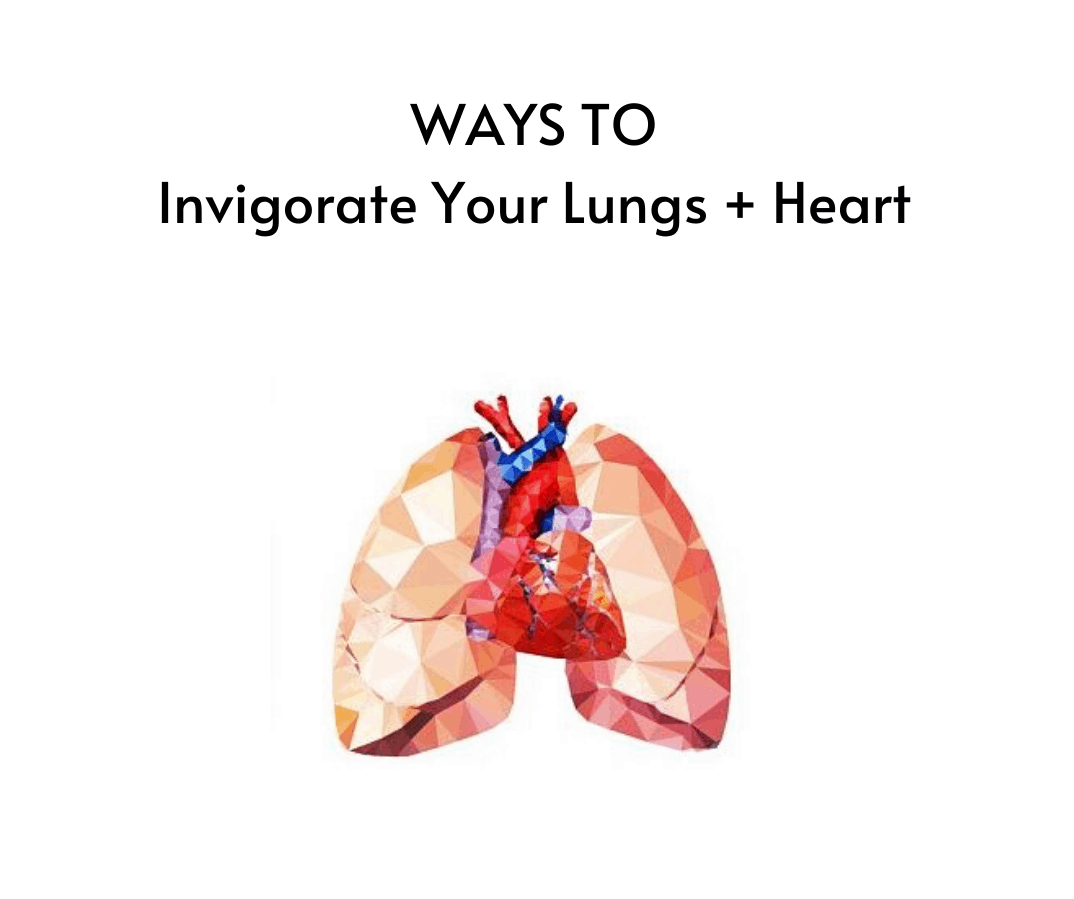Invigorating Heart + Lungs
Movement + somatic practices for stimulating breath, respiratory + nervous system health

There are so many ways we can support and expand our breath.
They don’t take a lot of space or time.
If we access high impact points and engage in high value movements, we can get HUGE returns that will last all day and build cumulatively over time.
Here are some high ROR things to consider…
Quick review –
The diaphragm and pelvic floor are reciprocal. During inhalation, when the diaphragm draws downward (concentric contraction), intra abdominal volume decreases and pressure increases, which requires the pelvic floor to respond by yielding. It has to elongate with pliability and still remain tone (eccentrically contracting). On exhalation, the opposite occurs. The pelvic floor moves up (concentrically contracting) as the diaphragm also moves up (eccentrically contracting). We need the pelvic floor to be pliable, able to yield and respond to the changes in intra abdominal pressure. When the pelvic floor is working well, the diaphragm can move more fully, we can take a bigger breath, and our entire respiratory system begins to function better.
While the feet and pelvic floor will encourage health and function in the diaphragm, what helps to fully liberate the breath, lungs, and heart is releasing the neck and upper back. Your deep neck and upper back muscles are secondary or accessory breathing muscles. They help to lift the top ribs and collar bones at the deepest part of the inhalation and allow for more capacity, blood flow, and — as strange as it might be — hydrate your internal organs.
Something Awesome You Might Not Have Known –
We know that slow, meditative breathing of any sort for even a minute or two, will — in most cases — trigger the parasympathetic nervous system and support our rest and digest function. This is CRITICAL right now. BUT the hidden and little-known BONUS is: when we move and breathe in a way that hydrates our viscera we are also tuning our vagus nerve, which innervates the majority of our organs. This lung and heart work is reciprocal: we move the diaphragm, pelvic floor, feet and organs to create better breathing and in doing so increase vitality in our vagus nerve, which then fosters even greater breathing capacity. The cycle continues, over and over again to nourish our bodies, cells, organs, and our spirits. Win. Win. Win.
Key Gateways to Breathing Better
Feet: Because our feet are fascially dense and innervated by the same nerves that innervate our pelvic floor and low back, they are directly connected to the healthy expanse and pliability of our diaphragm.
- Roll your feet
- Massage your feet
- Don’t forget about your toes
- Massage your calves
- Wring out your lower legs
- Toe sitting and other intentional foot/toe integration
- Calf raises, bouncing, working off balance
- Wobbling on an unstable surface or creating instability
- Wall falling with heel lift
Pelvic Floor: The hard truth is we’re all a bunch of tight-asses ;). We are a culture of sitters and the majority of us are sitting with rounded backs and shoulders, tucked tails, and forward heads. In this position, the base of the pelvis — specifically the sitting bones — narrow and our pelvic floors become constricted and hindered. We need to get the pelvic floor moving, resilient, and strong so it can partner with the diaphragm in the rhythm of breathing. And Kegel’s aren’t going to cut it.
- Cat/Cow
- Focus on spreading your sit bones as you go into Cow
- Cat/Cow with single leg open + close
- Reach one leg behind off the floor, turn your leg in, open your leg away from your midline/center and then across your midline/center (repeat 4-5 x each side)
- Sit on a medium sized soft ball for 5-10 breaths (a rolled up towel placed perpendicularly will also work)
- Focus on a soft belly breath on the inhale, imagining the sit bones widening; Imagine the sit bones gently (very gently) narrowing on the exhale
- Butterfly stretch (soles of feet together, knees fall open)
- Knee falls (on your back, knees bent, leg one knee fall open then the other)
Cervical Spine + Upper Back: Now to release the neck and upper back for the full breath monty. The double bonus of releasing this area is it also promotes vagal health, critical for nervous system function and regulation. And…it feels soooooooo GOOD!
- Jaw release – press and small circles
- Mouth washing
- Scalene release
- Cervical recurving and massage
- Upper trap grab
- Side bending exploration
- Spine rolls (with opposite eye tracking)
- Standing side with eye tracking
- Standing twist/swing (with opposite eye tracking)
*Most of the exercises listed here you’ll see at some point in the resilience practice videos below. For those not shown in the videos there are links to other support videos.*

 How are you showing up? Why are you showing up? Why do you teach? What IS teaching? Why do you care? This is Skillful Teaching: A Whole-person approach to being an expert teacher, not an expert technician. There's a difference. Want to know what it is?
How are you showing up? Why are you showing up? Why do you teach? What IS teaching? Why do you care? This is Skillful Teaching: A Whole-person approach to being an expert teacher, not an expert technician. There's a difference. Want to know what it is?